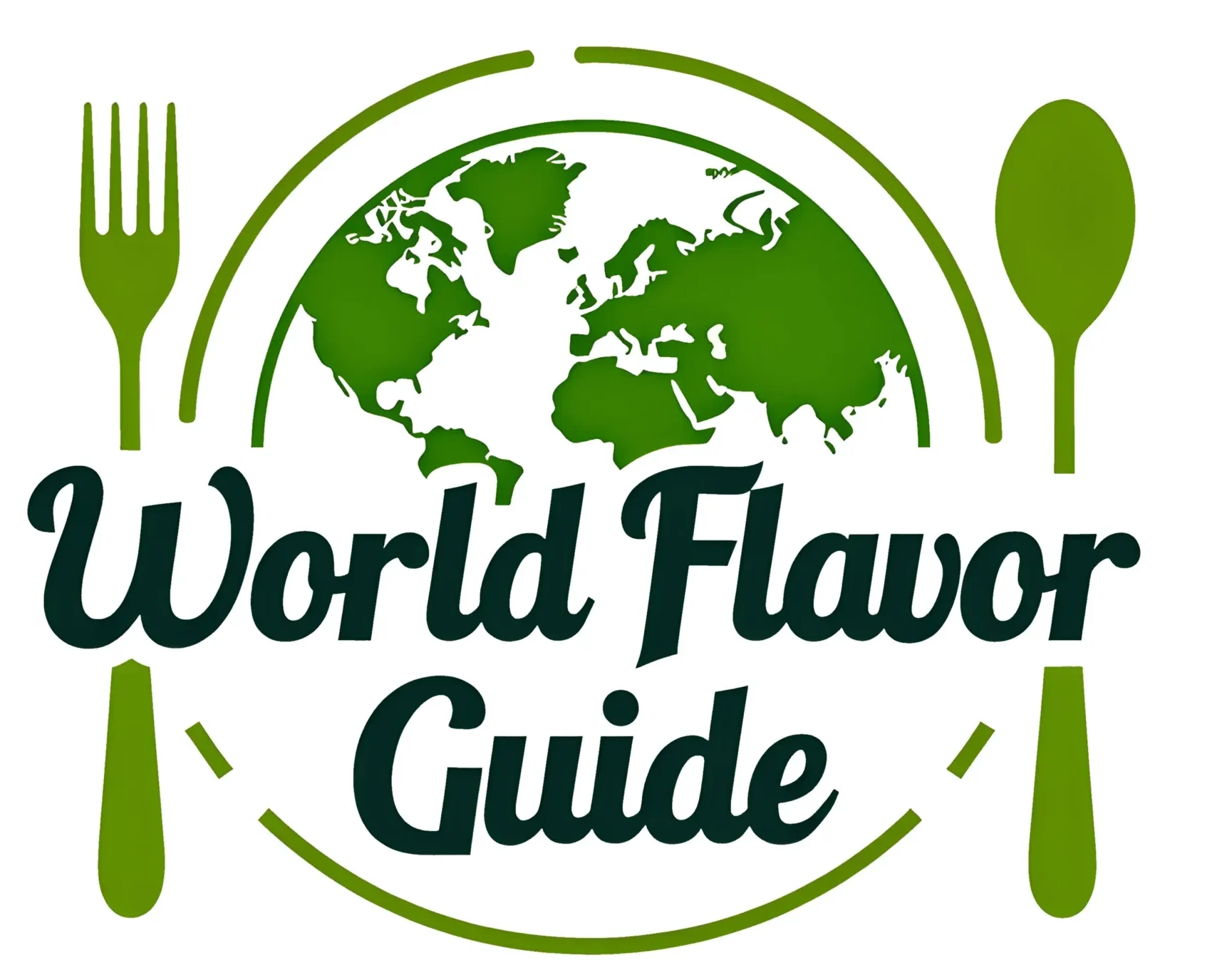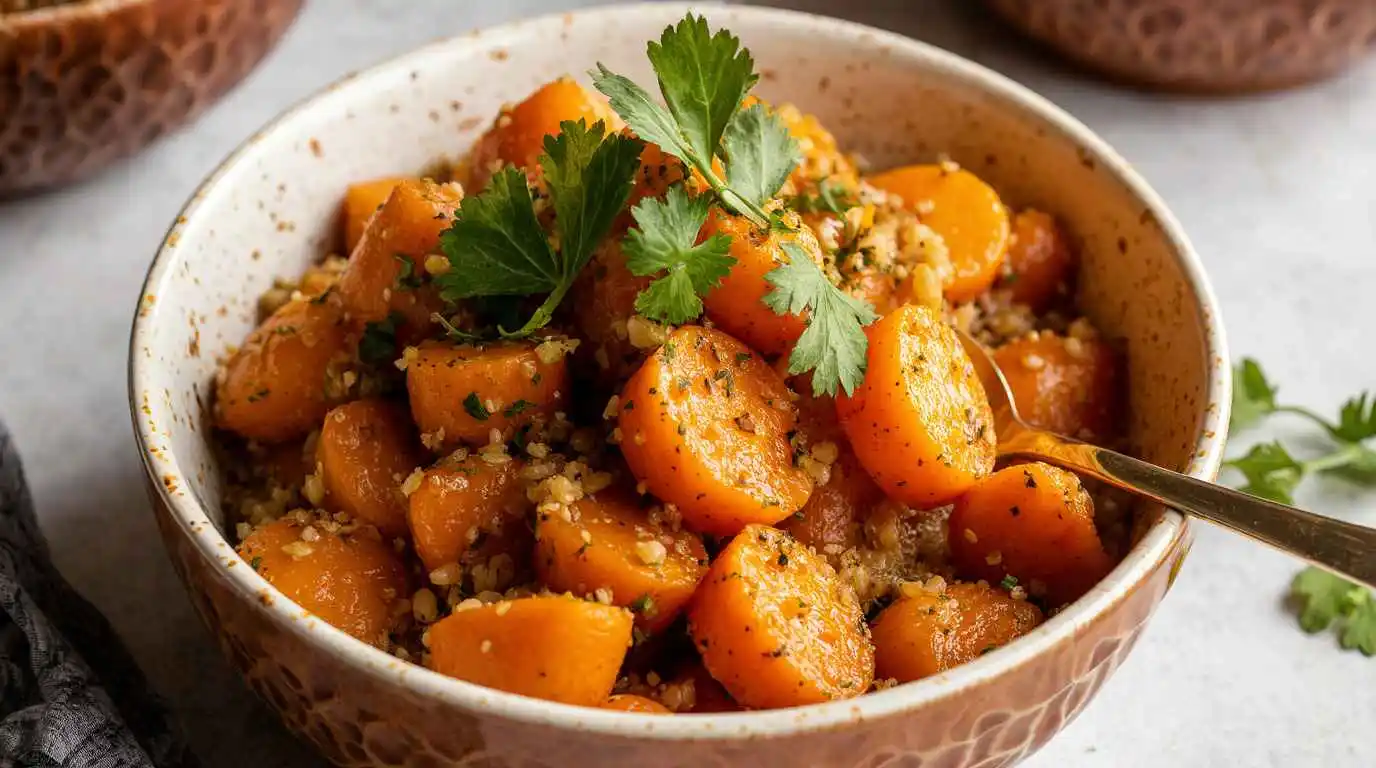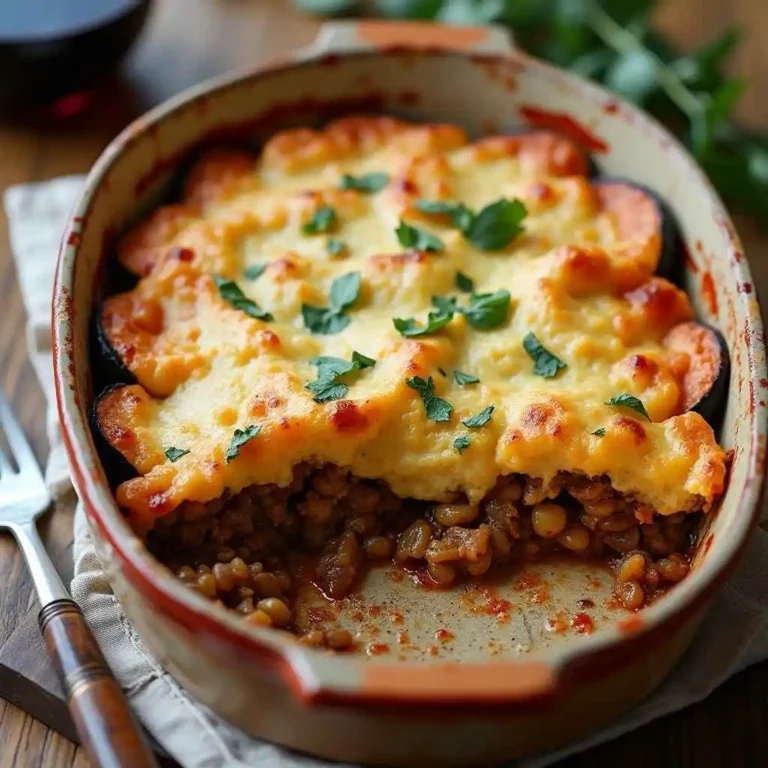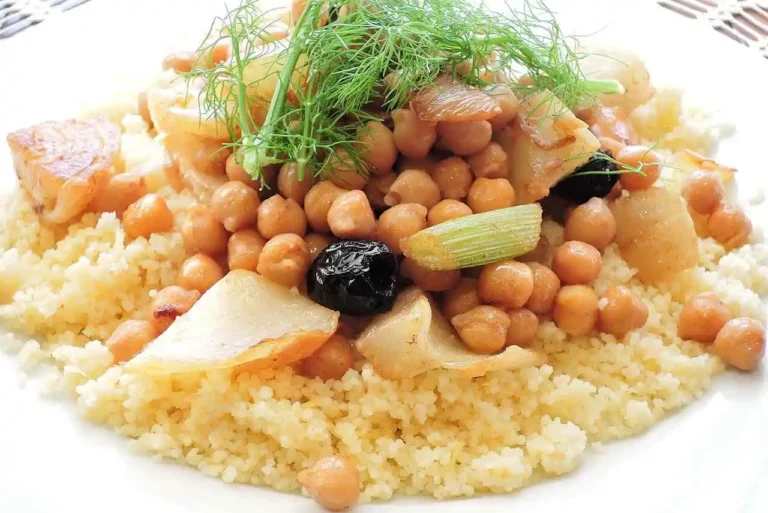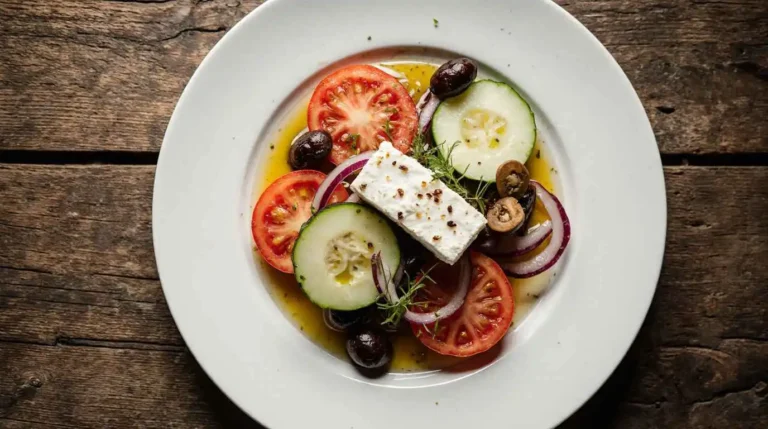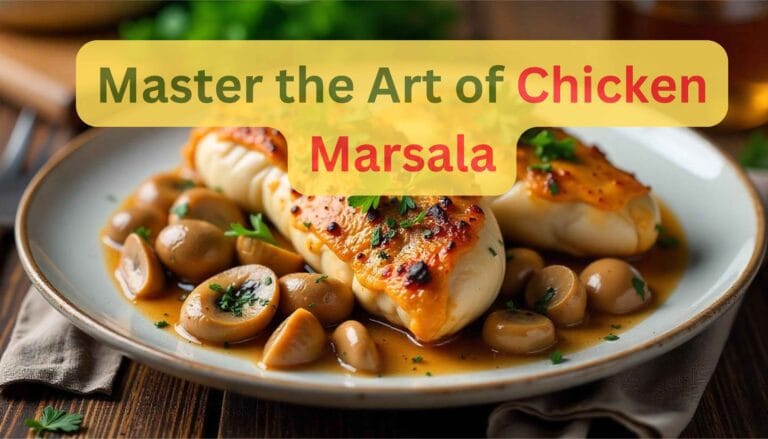Amazing Moroccan Carrot Salad: Transform Your Kitchen Today
Transport yourself to the vibrant souks of Marrakech with this authentic Moroccan carrot salad recipe that transforms humble carrots into a culinary masterpiece.
Table of Contents
More Than Just a Salad
Ever had something so heavenly it transported you to another realm? Picture yourself walking through Marrakech’s chaotic souks, the aroma of mysterious spices wafting through the air and colours so bright they seem to dance in front of you. That’s exactly what happens when you get to experience true Moroccan carrot salad – a meal that not only nourishes your body, but nourishes your spirit with centuries of cooking tradition.
This is not a salad recipe that you will forget about next week. This Moroccan carrot salad is a heavenly combination of sweet, salty, and aromatic ingredients that will forever transform what you think about humble ingredients. No matter if you’re looking to challenge your culinary limits or you just want to add more colorful and nutritious meals to your diet, this North African jewel of a salad will be your latest obsession.
What Makes Moroccan Carrot Salad So Special?
The charm of the Moroccan carrot salad lies in its breathtaking simplicity and elegant flavor. As compared to the raw vegetables and rich dressing focus of Western salads, this Mediterranean carrot salad worships carrots’ natural sweetness and imbues them with warm spices that have been valued for millennia.
Your tongue will be delighted by layers of flavor that unfold with every mouthful. Cumin’s earthiness, the warmth of cinnamon, the freshness of herbs, and the gentle burn of ginger are harmonized in a chorus that raises simple carrots to a level of real greatness. Your taste will be delighted by the Middle Eastern carrot salad variation with a glimpse into a cuisine that honors balance, nutrition, and sheer pleasure.
Its beauty is not just for the taste. The rich orange of well-cooked carrots, speckled with emerald green fresh herbs and golden spices, is a visual feast that will have your dinner table looking as if it has been set at a five-star restaurant. You are not just cooking food; you are creating an experience that connects you to generations of North African hospitality and tradition.
The Rich History and Origins
Being aware of the history of Moroccan carrot salad can only add to the enjoyment of every spoonful. It was born in the North African culinary melting pot of the kitchen, where Arab and Berber influences merged to produce something fundamentally Moroccan. Morocco’s indigenous peoples, the Berber, have long preserved and brought out the best in vegetables by judicious spicing right from the earliest days of their civilization.
Carrots played an especially significant role in Moroccan cuisine throughout history. Orange carrots, which we are used to today, weren’t always present; purple and white carrots used to be more common. How Moroccans can transform such humble root vegetables into intricate, fragrant dishes is a reflection of the Moroccan philosophy of luxury through simplicity – a concept that will revolutionize the way you cook.
Ancient trade routes via Morocco brought distant flavors for centuries. Those spices found their way into Moroccan carrot salad, and regional tastes and ingredients determined variation. You can sample this history in every judiciously seasoned bite of it today.
Essential Ingredients for Authentic Moroccan Carrot Salad
To make a good Moroccan carrot salad, you must also realize why each ingredient is important. Your success depends on selecting good ingredients that complement each other to achieve the perfect taste and texture.
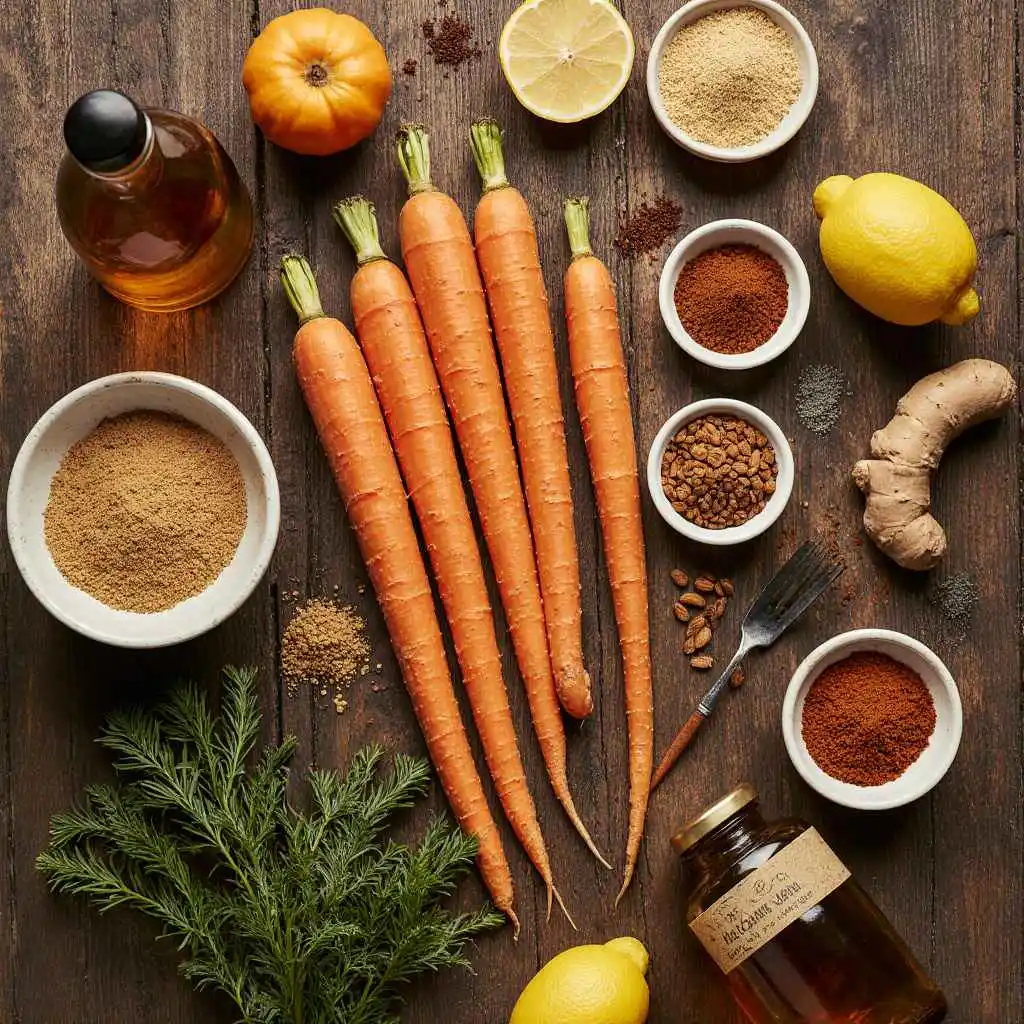
The Foundation: Selecting Perfect Carrots
The secret to any great Moroccan carrot salad recipe begins with the carrots themselves. You will need to choose medium, firm, bright orange, blemish-free carrots. Do not use baby carrots, as they lack the depth of flavor and texture this dish calls for. The carrots need to be sweet but not overly sweet, so that they may be used to provide the perfect foundation for the spice mixture.
The Spice Blend: Heart of the Recipe
Your spice selection will either make or break this dish. Your key spices are:
- Cumin: Contributes earthiness and warmth
- Cinnamon: Adds sweetness and depth
- Ginger: Contributes gentle heat and freshness
- Paprika: Provides color and mild pepper flavor
- Turmeric: Adds a golden hue and mild bitterness
- Coriander: Offers citrus, floral flavors
Fresh Components
Fresh ingredients are equally important. You will need fresh garlic for depth of flavor, fresh parsley and cilantro for freshness, and quality olive oil to bring it all together. Lemon juice provides the acidity to balance with the sweetness of the carrots, and the honey provides the hint of sweetness to bring out the sugars.
Preparing Your Carrots: The Professional Way
The secret to success with your cooked carrot salad recipes is to select and prepare the proper carrots. Select carrots the thickness of your thumb – not too thin that they will overcook, and not too thick that they will not cook through.
When you are cooking your Moroccan carrots, you get to choose. Traditional recipes tell you to cut the carrots into rounds, about a quarter-inch thick. This will make them cook without losing all their texture. Some cooks prefer diagonal cuts, which have more surface area on which the spices can adhere and provide a lovely look.
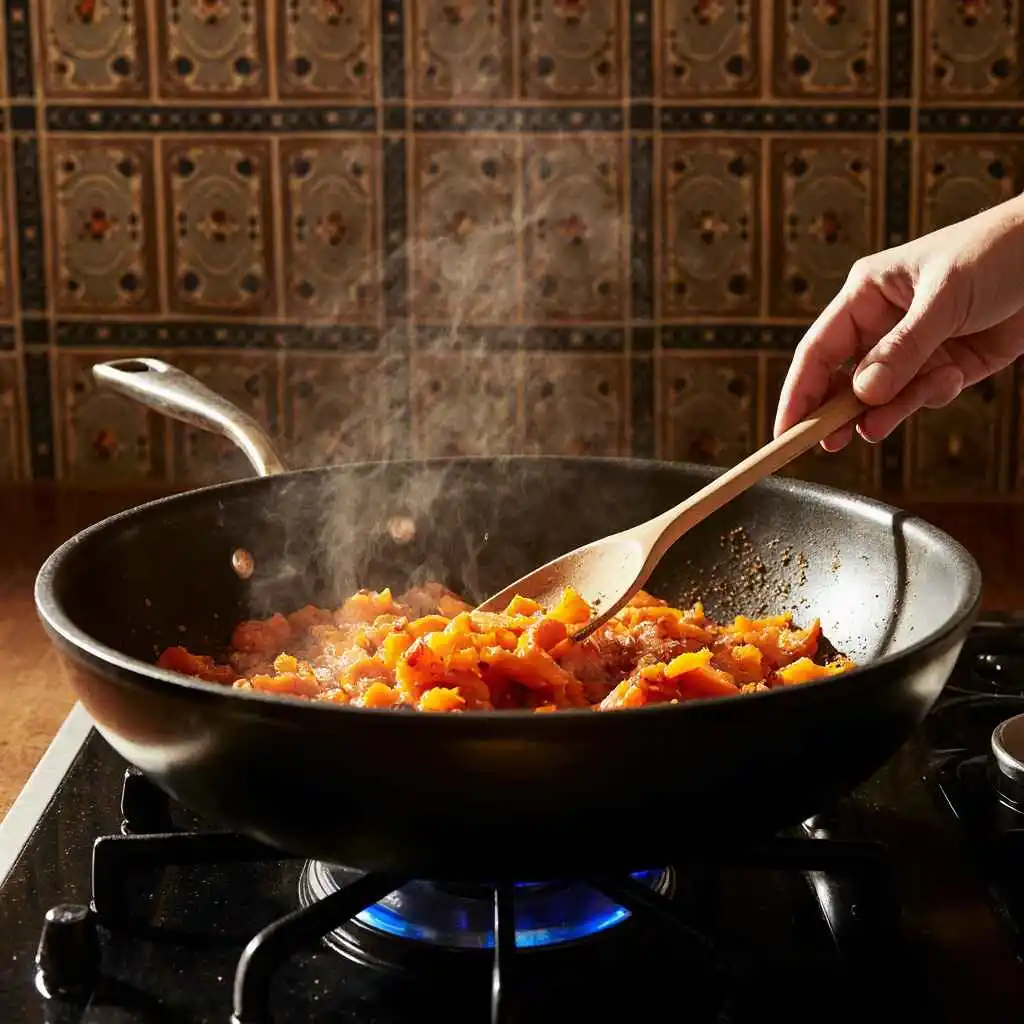
Your method of cooking will have a great deal to do with the final texture. Steaming is healthier and offers more control over texture than boiling. Having said that, there are some recipes where you braise the carrots in liquid, which contributes extra flavor to them. You can choose depending on your taste and the specific variation that you are using.
The Complete Moroccan Carrot Salad Recipe
And finally, the fun part – creating your masterpiece. This Moroccan carrot salad recipe has been refined by generations of Moroccan home cooks, and now you can bring this genuine experience into your own home.
Ingredients
| Ingredient | Quantity | Notes |
|---|---|---|
| Large carrots, sliced | 2 lbs | Cut into 1/4-inch rounds |
| Olive oil | 3 tablespoons | Extra virgin preferred |
| Garlic cloves, minced | 3 cloves | Fresh only |
| Ground cumin | 1 teaspoon | Freshly ground if possible |
| Ground cinnamon | 1/2 teaspoon | Ceylon cinnamon preferred |
| Fresh ginger, grated | 1 tablespoon | Peel before grating |
| Sweet paprika | 1 teaspoon | Hungarian or Spanish |
| Ground turmeric | 1/4 teaspoon | For color and flavor |
| Ground coriander | 1/2 teaspoon | Freshly ground preferred |
| Honey | 2 tablespoons | Adjust to taste |
| Fresh lemon juice | 3 tablespoons | From 1 large lemon |
| Fresh parsley, chopped | 1/4 cup | Flat-leaf preferred |
| Fresh cilantro, chopped | 1/4 cup | Optional but recommended |
| Salt | To taste | Sea salt preferred |
| Black pepper | To taste | Freshly cracked |
Step-by-Step Instructions
Your journey to creating the perfect Moroccan carrot salad begins with preparation. Begin by washing and peeling your carrots and cutting them into equal-sized pieces. This will aid you in attaining consistent cooking and a professional look.
- Prepare the aromatics: Warm the olive oil in a large, heavy frying pan over medium heat. Add in the minced garlic and cook for only a little more than 30 seconds until it’s fragrant – don’t let it burn, though. It should have a sweet smell, not a bitter one.
- Cook the carrots: Place your sliced carrots in the pan and stir them to coat with garlic oil. Cook for 2-3 minutes, stirring every now and then, until the carrots begin to soften slightly around the edges.
- Add the spices: No, wait for the moment of magic – the addition of spices. Sprinkle the cumin, cinnamon, ginger, paprika, turmeric, and coriander over the carrots. Stir constantly for about 1 minute, allowing the spices to become fragrant and evenly coat the carrots. This technique, “blooming” the spices, unleashes the essential oils and brings out their flavors.
- Simmer: Add enough water to barely cover the carrots, and stir in the honey. Bring to a low boil, then reduce heat to low. Cover the pan and simmer for 15-20 minutes, stirring occasionally, until the carrots are tender but still hold their shape.
- Reduce: Remove the lid and keep the heat on medium-high. Keep stirring and cook 5-7 minutes longer, until most of the liquid has evaporated and the carrots are nicely coated with the spice mixture.
- Finish: Off heat, whisk in the lemon juice at once. Taste and season with salt and pepper. Cool the salad to room temperature, then whisk in fresh herbs shortly before service.
Mastering Moroccan Spice Combinations
The secret to wonderful Moroccan carrot salad is understanding how spices play together. Each spice is in there for a purpose, and learning their balancing points will elevate your cooking to a completely different level than simply following recipes.
Cumin is the base of most Moroccan spice blends. Its earthy, slightly bitter flavor brings depth and richness that complements the natural sweetness of carrots. When you shop for cumin, attempt to purchase whole seeds whenever possible and grind them yourself for the best flavor.
Cinnamon adds warmth and sweetness, but don’t use just any cinnamon. Ceylon cinnamon, or “true cinnamon,” is a more delicate, more complex flavor than the more common cassia cinnamon in most grocery stores. If you can find Ceylon cinnamon, your Moroccan carrot salad will be more true to flavor.
The fresh ginger and ground coriander mix to create a light, citrusy taste that prevents the dish from becoming too heavy. Use fresh ginger – ground ginger won’t be able to impart the same light flavor. Grate it very finely so the flavor gets dispersed throughout the dish.
Hot vs. Cold Serving Options
One of the pleasant aspects of Moroccan carrot salad is that it is flexible in its serving temperature. Although traditionally served at room temperature or even slightly warm, you can adapt this dish to suit different seasons and events.
Warm Service
Served warm, the Moroccan carrot salad recipe is a delicious side dish to accompany grilled meats and roasted chicken. Warm spices are enhanced by rich proteins, and the carrots provide a sweet contrast to rich main courses. The salad must be served immediately for optimal flavors.
Cold Service
For cold service, allow the salad to come to room temperature and chill for a minimum of 2 hours. Moroccan carrot salad tastes best cold, with spices having had time to blend. It is an excellent addition to a mezze platter or as a cold side on a hot day.
Raw Variation
You can also prepare a raw version by grating the carrots and mixing them with the same spice mixture and dressing. It has a completely different texture but the same original taste. The raw version is particularly nice during the summer when you do not want to cook on the stove.
Regional Variations Across the Mediterranean
The impact of the Moroccan kitchen is felt throughout the Mediterranean, and thus interesting variations of carrot salad are found in numerous cultures. Knowing such things enables you to appreciate the broader context of the dish and motivates you to try making your variations.
Greek Influence
There is a comparable dish in Greek cooking called “karpouzi salata” that employs the majority of the same spices but has feta cheese and olives. Both of these ingredients give more substance to the dish and render it usable as a light meal rather than a side dish.
Turkish Interpretation
Turkish cuisine features “havuç salatası,” a Moroccan carrot salad-like sweet-and-savory dish, but one with sumac contributing tartness and pomegranate molasses for depth. The ingredients provide a more diversified flavor profile because of Turkey’s geographical position between Europe and Asia.
Italian Adaptation
Italian cuisine, particularly in southern Italy, incorporates carrot dishes with the same method of spicing. The “carote alla marocchina” in some Italian restaurants shows how Moroccan immigrants played their part in local cuisine, creating fusion foods that honor both traditions.
Middle Eastern Variations
Middle Eastern cuisine as a whole has numerous variations of carrot salads that are spiced, each reflecting regional taste and ingredients. They are a testament to how well one simple concept can be reimagined in another cultural setting.
Lebanese Style
Lebanese cuisine features “jazar bi zeit,” a cold carrot salad that illustrates the application of fresh herbs and high-quality olive oil. The Lebanese version will probably include mint and less cinnamon than the Moroccan version, resulting in a lighter, more herbaceous flavor.
Syrian Tradition
Syrian carrot salad, or “salatet jazar,” traditionally contains walnuts and pomegranate seeds, both of which contribute texture and nutrients to the salad. They make the salad more substantial and turn it into a meal when served with flatbread.
Egyptian Approach
Egyptian food also has “salata baladi,” which normally includes carrots along with other vegetables in a seasoned blend. The Egyptian version is hotter and may use hot peppers for added intensity in the dish for individuals who desire more spice.
Serving Suggestions and Perfect Pairings
Your Moroccan carrot salad should be displayed in a way that honors its cultural heritage and is pleasing to the modern eye. The salad is a versatile one that can be served at many occasions and meals.
Traditional Moroccan Meals
To enjoy authentic Moroccan cuisine, serve your carrot salad with tagines and couscous, or grilled meat. The savory flavors and sweetness complement the rich, slow-cooked stews common in Moroccan cuisine. The bright colors also provide a contrast to earth-colored tagines and plain couscous.
Modern Fusion Options
For modern fusion food, this Mediterranean carrot salad works well as part of a mezze platter. Serve it alongside hummus, baba ganoush, tabbouleh, and warm pita bread for a complete Middle Eastern dining experience. The variety of textures and flavors creates an interactive dining experience that promotes sharing and conversation.
Casual Dining
For a relaxed gathering, experiment by serving the salad as a side dish for grilled vegetables or barbecued meats. The spices complement smoky fare while providing a bright, colorful addition to your outdoor dining table.
Wine Pairings
Wine pairings for Moroccan carrot salad need to complement the sweet and spicy flavors. Light reds such as Pinot Noir or Beaujolais work well, as do Gewürztraminer or Viognier. If you prefer a non-alcoholic beverage, mint tea or lemon-sparkling water is an ideal refreshing accompaniment.
Storage and Meal Prep Guide
Good storage keeps your Moroccan carrot salad fresh in texture and flavor for days. The salad even improves with time because the spices get a chance to further blend and mature in flavor.
Refrigerator Storage
Store your pre-prepared salad in an airtight container in the refrigerator for five days. The carrots will continue to take up the flavor, and day-old salad tastes better than salad made fresh. Serve using clean serving utensils to avoid contamination and add to shelf life.
Meal Prep Tips
To pre-plan meals, you can cook the carrots three days before and keep them separately from the fresh herbs. Add the herbs only at the time of serving to retain the fresh color and flavor of the herbs. In this manner, you can enjoy ready-to-eat salad for a week.
Freezing Considerations
Freezing is possible but not recommended for this recipe. The carrots become vastly different in texture when frozen and thawed out, becoming mushy and losing their appealing crunch. Portions work best frozen when served as an ingredient in a soup or a stew rather than served as a salad by itself.
Nutritional Benefits and Health Considerations
Other than its incredible flavor, Moroccan carrot salad also possesses incredible nutritional benefits that make it perfect for your healthy diet. You can discover these strengths to understand why the dish has been a favorite for so many generations.
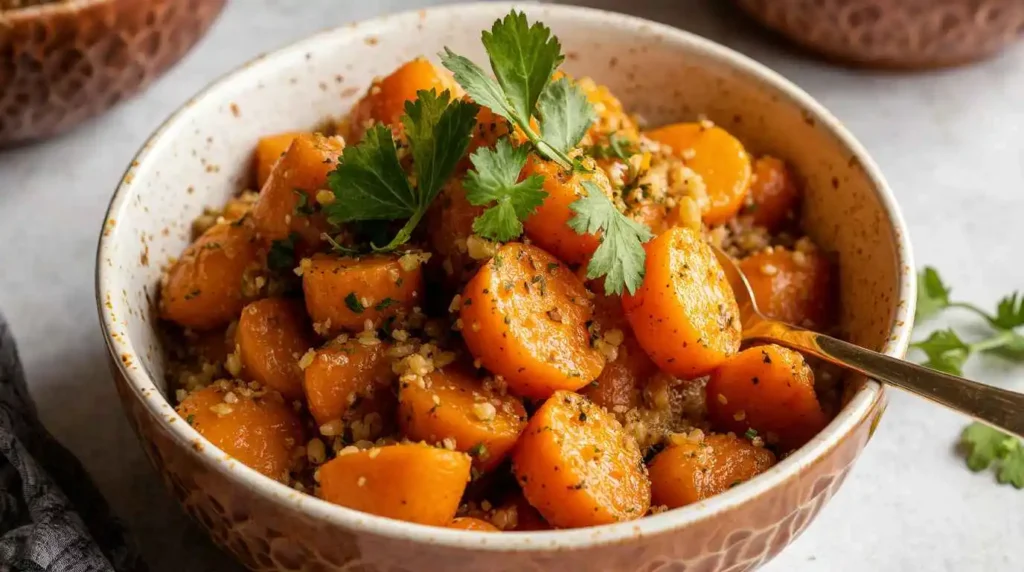
Vitamin Powerhouse
Carrots are notably rich in beta-carotene, which your body converts into vitamin A. Vitamin A is essential to the well-being of your eyes, immune system, and skin. You’ll get more than a day’s worth of vitamin A from one serving of this salad, so this salad is a nutritional powerhouse masquerading as a delicious side dish.
Spice Health Benefits
The spices used in Moroccan carrot salad recipe also each have their health benefits:
- Cumin aids in digestion and is anti-inflammatory
- Cinnamon regulates blood sugar and is an antioxidant
- Ginger aids in digestive health and is anti-nausea
- Turmeric contains curcumin, a powerful anti-inflammatory substance that aids in joint health
Healthy Fats and Nutrients
The olive oil gives you healthy monounsaturated fats, which enable your body to absorb the fat-soluble vitamins. The synergy between the olive oil and the beta-carotene in the carrots maximizes the absorption of nutrients.
The fresh herbs add vitamin C, folate, and other antioxidants that aid immune function and general well-being. The lemon juice adds additional vitamin C and preserves the vegetables’ bright colors.
Troubleshooting Common Cooking Issues
Even experienced cooks sometimes experience problems preparing Moroccan carrot salad. Familiarity with common mistakes prevents you from repeating the same errors and guarantees perfect outcomes every time.
Overcooked Carrots
The most common error is overcooking the carrots. Carrots need to be tender but retain some bite. If they are mushy, not only will they have lost their pleasant texture, but they can also make the stew watery as well. Check for readiness by sticking a fork in – it should go in easily but encounter some resistance.
Burnt Spices
It will ruin the entire dish if you burn the spices. Spices must be full of flavor but not smoky or darkened. If you somehow end up burning them, start over with fresh spices. Burnt spice bitterness cannot be covered up with other ingredients.
Under-Seasoning
Underseasoning is most often due to cooks being too nervous to use sufficient salt. Vegetables need to be seasoned to bring out their flavors. Season and taste towards the end of cooking, keeping in mind that flavors develop as the dish cools.
Herb Timing
Adding herbs too early causes them to lose their vibrant color and fresh flavor. Add fresh herbs just before the serving time to maintain their appearance and vibrant flavor.
Spice Balance
Imbalanced ratios of spices can overpower or underpower the dish. Use the quantities recommended and then adjust to taste. Remember that you can always add, but you cannot take away excess spices.
Frequently Asked Questions
Can I make Moroccan carrot salad ahead of time?
Yes, Moroccan carrot salad tastes even better prepared in advance. Prepare the dish up to 24 hours in advance, but add fresh herbs at the last minute to maintain their color and freshness.
How do you keep leftover Moroccan carrot salad?
Store in an airtight container in the refrigerator for 5 days. The flavors will blend and intensify after a while, and the leftovers tend to be more delicious than the dish is when it is newly prepared.
Can I substitute dried herbs for fresh in this Moroccan carrot salad recipe?
Although fresh herbs are preferable because of their strong color and flavor, you can make do with dried herbs with approximately 1/3 of the amount. Add dried herbs to the cooking process instead of at the end.
Is Moroccan carrot salad suitable for special diets?
Yes, this recipe is vegan, gluten-free, and paleo by nature. It will also be suitable for most Mediterranean and Middle Eastern diets.
Can I adjust my Middle Eastern carrot salad to be spicier or less spicy?
Add more or less ginger and/or add cayenne pepper for extra heat. Reduce the ginger and omit any spicy spices for less heat. The greatest thing about this recipe is that it can be made to suit everyone’s taste.
Can I make this recipe using baby carrots?
While possible, baby carrots lack the flavor and texture of normal carrots. If employing baby carrots, cook as instructed and expect a less intense flavor experience.
Conclusion: Your Gateway to Moroccan Cuisine
Your culinary journey to Moroccan carrot salad brings you to a great North African food tradition boasting simplicity, flavor, and healthiness. The salad captures everything wonderful about Moroccan food – the ability to transform the ordinary into the exceptional by means of careful spicing and preparation.
The skill you’ve gained from this recipe transcends the single dish. You’ve learned to balance sweet and savory, to bloom spices to their maximum potential, and to master the texture, and these skills will carry you through every culinary endeavor. You now possess the key to crafting not only a side dish but a cultural phenomenon that unites you with centuries of culinary heritage.
Whether you’re making this Mediterranean carrot salad as one of a lineup of special-occasion foods or simply want to add more beautiful, healthy meals to your weekly meal prep, you’ve got all you need to succeed. The recipe is forgiving for a beginner but refined enough to impress experienced cooks and dinner party guests alike.
Remember that cooking is a journey, and that this recipe is merely your starting point, not your destination. Make no apologies for adjusting spices to suit your taste, experimenting with other herbs, or incorporating elements of other Middle Eastern carrot salads that you find.
Ready to start your Moroccan cooking journey? Start off by collecting ingredients you’ll require and setting up your mise en place. Take your time through each step, savoring the smells and colors as they are revealed. Share your dish with friends and loved ones, and be sure to tell them about the rich heritage behind each delicious bite.
Your kitchen is now a doorway to the exotic tastes of Morocco. So, the question remains: when will you begin cooking?
Tried This Recipe? Tell Us What You Think!
There are no reviews yet. Be the first one to write one.
